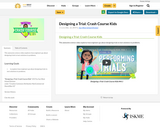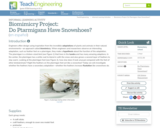
This awesome science video explores how engineers go about designing trials to test solutions to problems.
- Subject:
- Science
- Material Type:
- Activity/Lab
- Lesson
- Provider:
- Crash Course Kids
- Date Added:
- 12/12/2019

This awesome science video explores how engineers go about designing trials to test solutions to problems.

Students acquire a basic understanding of the science and engineering of space travel as well as a brief history of space exploration. They learn about the scientists and engineers who made space travel possible and briefly examine some famous space missions. Finally, they learn the basics of rocket science (Newton's third law of motion), the main components of rockets and the U.S. space shuttle, and how engineers are involved in creating and launching spacecraft.

Students are introduced to detail drawings and the importance of clearly documenting and communicating their designs. They are introduced to the American National Standards Institute (ANSI) Y14.5 standard, which controls how engineers communicate and archive design information. They are introduced to standard paper sizes and drawing view conventions, which are major components of the Y14.5 standard.

Students disassemble and analyze retractable pens. Through the process of "reverse engineering," they learn how the ink pens work.

Students discover the mathematical constant phi, the golden ratio, through hands-on activities. They measure dimensions of "natural objects"—a star, a nautilus shell and human hand bones—and calculate ratios of the measured values, which are close to phi. Then students learn a basic definition of a mathematical sequence, specifically the Fibonacci sequence. By taking ratios of successive terms of the sequence, they find numbers close to phi. They solve a squares puzzle that creates an approximate Fibonacci spiral. Finally, the instructor demonstrates the rule of the Fibonacci sequence via a LEGO® MINDSTORMS® NXT robot equipped with a pen. The robot (already created as part of the companion activity, The Fibonacci Sequence & Robots) draws a Fibonacci spiral that is similar to the nautilus shape.

In this lesson, students will learn how cosmic rays were discovered and what they are - including their size and speed. Includes background information for the teacher, questions, activities and information about student preconceptions. This is lesson 1 of 4 from "The Cosmic Ray Telescope for the Effects of Radiation (CRaTER)."

This is an activity about the Hubble Deep Field image, an observation of one small area of sky that contained no previously-detected objects. The long time exposure of this image allows us to detect some of the most distant objects seen in our Universe. Learners will view an image of the Hubble Deep Field and identify how many distant galaxies are visible as well as the types of galaxies they might be. Observations will be taken a step further to infer predominant age of a galaxy and determine if there are any trends in age (color) versus galaxy size or type and, ultimately, if the distant Universe appears relatively uniform. This activity is Astronomy Activity 4 in a larger resource, titled "Space Update."

Students learn about biomimicry and the engineering design process as they design and build model ptarmigan feet.

Students explore the concept of optical character recognition (OCR) in a problem-solving environment. They research OCR and OCR techniques and then apply those methods to the design challenge by developing algorithms capable of correctly "reading" a number on a typical high school sports scoreboard. Students use the structure of the engineering design process to guide them to develop successful algorithms. In the associated activity, student groups implement, test and revise their algorithms. This software design lesson/activity set is designed to be part of a Java programming class.

This is an online lesson which introduces the concept of astronomical filters and their connections to imaging different objects in space. Learners will explore perceptions of images as seen using different colors of light, construct a filter wheel, and practice investigating various astronomical images using the filter wheel. This material was designed to highlight how filters are useful to astronomers and show how a real astronomical telescope uses filters to image the Sun.

Testing is critical to any design, whether the creation of new software or a bridge across a wide river. Despite risking the quality of the design, the testing stage is often hurried in order to get products to market. In this lesson, students focus on the testing phase of the software/systems design process. They start by exploring existing examples of program testing using the CodingBat website, which contains a series of problems and challenges that students solve using the Java programming language. Working in teams, students practice writing test cases for other groups' code, and then write test cases for a program before writing the program itself.

In this activity, students use the binary number system to transmit messages. Two flashlights are used to demonstrate how astronomy spacecraft to transmit images and other scientific data to Earth. This activity is part of Unit 4 in the Space Based Astronomy guide that contains background information, worksheets, assessments, extensions, and standards.

In this activity, students simulate how light collected from a space object converts into binary data and reconverts into an image of the object. A pencil and paper activity demonstrates how astronomical spacecraft and computers create images of objects in space. This activity is part of Unit 4 in the Space Based Astronomy guide that contains background information, worksheets, assessments, extensions, and standards.

Students practice creating rudimentary detail drawings. They learn how engineers communicate the technical information about their designs using the basic components of detail drawings. They practice creating their own drawings of a three-dimensional block and a special LEGO piece, and then make 3D sketches of an unknown object using only the information provided in its detail drawing.

Students use a compass and a permanent magnet to trace the magnetic field lines produced by the magnet. By positioning the compass in enough spots around the magnet, the overall magnet field will be evident from the collection of arrows representing the direction of the compass needle. In activities 3 and 4 of this unit, students will use this information to design a way to solve the grand challenge of separating metal for a recycling company.

This Super Lesson utilizes Project Based Learning to assist learners with designing, building, and testing flying contraptions as an introduction to Engineering. The goal of this project is to engage students in collaborative team work and to introduce students to the Science and Engineering Practices: Asking Questions and Defining Problems, Planning and Carrying Out Investigations, and Constructing Explanations and Designing Solutions.
We have offered this Super Lesson as an 8-week elective course, developing and strengthening student interest in applied Math and Science topics. It could also be offered within upper elementary or middle school Science and Math courses. In addition, each week’s topic could be used as a stand alone mini-lesson if time is limited. We have worked to include multiple options within this unit to make it accessible to both general education and special education programs, including recommendations for modifications and extensions.

This is a lesson about spacecraft design. Learners will use the information learned in previous lessons, combined with their own creativity and problem-solving skills, to design and test a parachuting probe that will withstand a fall from a high point, land intact, be able to descend slowly, float in liquid, and cost the least to launch into space. Extensions provide an option if the teacher has limited time, and invite the students to simulate other experiments that will be carried out by the Huygens probe. This is lesson 9 of 12 in the Mission to Saturn Educators Guide, Reading Writing Rings, for grades 3-4.

Today we’re talking about mass transfer. It doesn’t just apply to objects and fluids as a whole, but also to the individual molecules and components that make them up. We’ll see that transfers of mass need their own driving force, discuss diffusion, and use Fick’s Law to help us model mass transfer.

This movie provides an 18-minute introduction to how NASA is observing our ever-changing planet. On the The Dynamic Earth DVD Web page you can download the video as an iPod or iPhone version, as well as an AppleTV/Full resolution version, and access a glossary and links to related Web sites.

In this chapter, students will explore relationships between air quality and population density using the image visualization tool, Google Earth. You will learn how to download NO2 data and analyze them to develop a conceptual understanding of how population and topography can influence the air quality of a region. Once you have learned the techniques, you are encouraged to explore seasonal changes in nitrogen dioxide concentrations at other locations. This chapter is part of the Earth Exploration Toolbook (EET). Each EET chapter provides teachers and/or students with direct practice for using scientific tools to analyze Earth science data. Students should begin on the Case Study page.